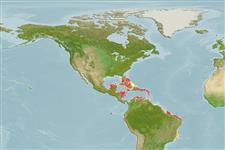Common names from other countries
Environment: milieu / climate zone / depth range / distribution range
Ecologia
; intervalo de profundidade 0 - 10 m (Ref. 2022). Tropical
Western Central Atlantic: Colombia.
Length at first maturity / Tamanho / Peso / Idade
Maturity: Lm ? range ? - ? cm
Epibiotic (Ref. 110502). Intertidal to sublittoral, under stones (Ref. 2022).
Life cycle and mating behavior
Maturidade | Reprodução | Desova | Ovos | Fecundidade | Larvas
Members of the class Polyplacophora are mostly gonochoric. Life cycle: Eggs hatch into lecitotrophic planktonic trocophore larvae (no veliger stage) which later metamorphose and settle on the bottom as young adults.
Gracia, A.C., J.M. Diaz and N.E. Ardilla. 2005. (Ref. 2022)
Categoria na Lista Vermelha da IUCN (Ref. 130435)
Categoria CITES (Ref. 108899)
Not Evaluated
Not Evaluated
Utilização humana
| FishSource |
Ferramentas
Mais informação
Idade/Tamanho
Crescimento
Comprimento-peso
Comprimento-comprimento
Morfologia
Larvas
Abundância
Fontes da internet
Estimates based on models
Preferred temperature
(Ref.
115969): 26.1 - 28.1, mean 27.4 (based on 525 cells).
Categoria de preço
Unknown.
